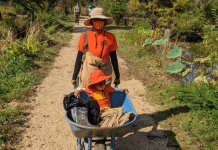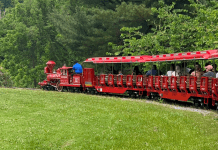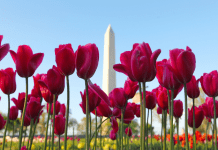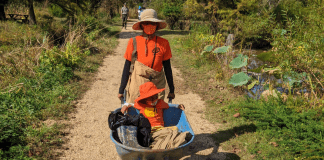Article by guest writer Kelsi Folsom.
Shoes are tied and lunches are packed. We’re ready for a mini road trip to Monocacy National Battlefield, an historic Civil War site about forty minutes from where we live. Although uncertain how Civil War history would hold my preschoolers’ attention, I thought at the very least, we could picnic somewhere beautiful.
After a brief stop at the visitor’s center, we pull off into the first of five locations, titled “Best Farm.” It is here on July 9th of 1864 that Lee launched an offensive against Union Troops, hoping to secure his advance on Washington D.C. Although not the largest battle fought, it is deemed one of the most important, often called “The Battle that Saved Washington.”
Fluffy white clouds like lamb’s wool arranged themselves brightly against a sky the color of Caribbean waters. Edward Hopper would have killed to paint this vista. I can’t imagine how the desire to kill somebody didn’t dissipate in awe over the picturesque tranquility.
We park and spill out the sides of the van, the kids dashing off in the direction of an empty mill house. I continue surveying the land, trying to wrap my mind around the sights, sounds, and feelings swallowed up in the earth, each granule of dirt a keeper of someone’s fate.
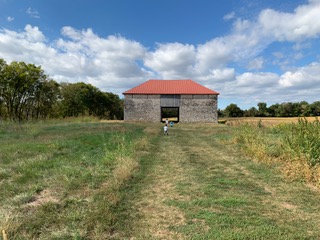
Beauty can hide such secrets; the land begged to have its horrors acknowledged, but there was also a pride that it had survived and could still be beautiful. Men died for the right to choose, for the right to be human and free.
The kids poke around with their walking sticks, peeking through windows and clambering on antique cannons, having no clue they were instruments of death. Just another play structure in their minds.
“Do you know where we are?” I ask the kids, knowing full well they didn’t.
“A beautiful old house!” my daughter exclaims with pride.
“Yes, that’s true, but do you know what happened here?”
*crickets*
“Long ago there was a war called the Civil War and one of the battles was fought right here.”
“Why were they fighting?” my daughter asks, her bright blue eyes quizzical.
I had debated with myself on the drive over, whether or not to open up a conversation about the Civil War. Since my daughter asked, I decided to wade in and just do my best.
“Well, people had some very different ideas about how the government should run and how America should be a country. They weren’t able to work through their differences, so they decided to fight each other with guns and cannons.“
I wanted to tell her that people weren’t sure how far to take personal liberty and at what cost. People weren’t sure if all humans had equal rights and who got to decide who did and didn’t have access to the fullness of the American table. At what point did a human life garner full protection by the United States, and does the end actually justify the means? Should businesses be held accountable for their methods?
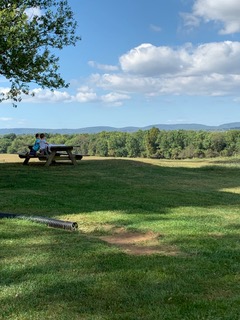
I wasn’t sure how to introduce the concept of slavery to a 4 year old, beyond “certain people groups were being treated unfairly and our president at the time, Abraham Lincoln, wanted to make sure that everybody in America experienced freedom.” I left it at what appeared to be a satisfactory explanation to her.
On a snack whim, we head back to the van to procure goldfish before rumbling towards our next stop. Twisting through the rolling farmland we approach Worthington House perched atop a hill with one wooden picnic table seated beneath the shade of a large tree leaning into a sprawling view of the Appalachian Mountains.
This is so much better than the McDonald’s Playplace!
I wasn’t sure what to expect, but wide open spaces for the kids to run around and beautiful historic locales for me to nerd out about, were just what we needed.

After PB&J sandwiches and red apples are consumed, we snap photos on the front steps and play chase before piling back into the van. Feeling collective exhaustion creeping in, I ask the kids if they want to go home or keep adventuring? They choose the latter, so we pull into the last stop, Gambrill House, which at the time served as a makeshift hospital for fallen soldiers.
A short nature trail to our left, leading down to the Monocacy River pulls our attention, especially after a couple with four small dogs in tow heads down the path. We follow along looking for squirrels and observing the butterflies and fall colors spreading over the leaves of the trees. Dashing towards the river’s edge, the kids busy themselves finding the biggest rocks and tossing them into the river, while I consider the peace of the sunshine and the gently flowing waters. We stood between two bridges, one of which had been burned down during the war to keep confederate troops from advancing.
My heart warmed at the small way I could redeem the tragedies this river has seen, having once flowed red with the blood of warring ideas. My carefree day frolicking on the battlefields was my way of saying “thank you” and projecting a different way for future generations to walk the earth—in mercy, justice, and peace.

Our adventure came to a close, and we headed home with flushed cheeks and full hearts. Not only do historic battlegrounds make great places for young ones to play, they provide an opportunity to breach important conversations that will shape how our children think and move in their own future spheres of influence. Lessons in peacemaking, beyond “wait your turn,” and “find something else to play with,” can begin now, even at ages 3 and 4.
About our Guest Author:
Kelsi Folsom loves laughing and crying about the ups and downs of marriage and motherhood, preferably over a good cup of coffee. She is a regular contributor to Red Tent Living (where many of these conversations end up), and enjoys traveling with her husband and three kids, scouring estate sales, getting lost in a good novel, and occasionally putting her B.M. in Voice Performance to good use. Her work is published in The Caribbean Writer, Motherly, Women Who Live on Rocks, Knocked Up Abroad, Voice of Eve, and elsewhere. She’s also a poet, and her first full length collection of poetry, Buried in the Margins, releases with Finishing Line Press in 2020. Follow her writing and activities at www.kelsifolsom.com and on Instagram @kelsifolsom.



